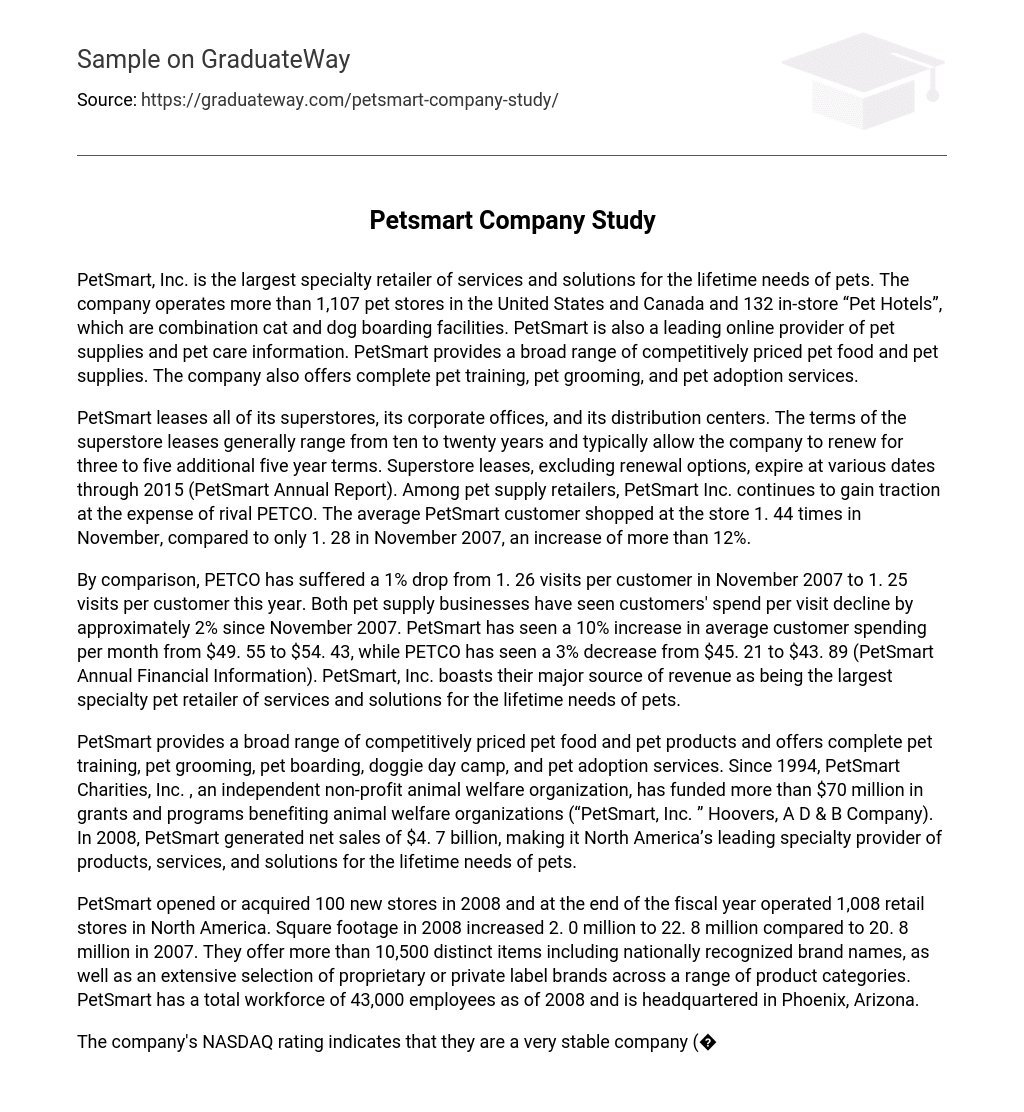PetSmart, Inc. is the largest provider of services and solutions for pets’ lifetime needs. It has over 1,107 pet stores in the United States and Canada, as well as 132 in-store “Pet Hotels” that offer cat and dog boarding facilities. PetSmart is a leading source for all things pet-related, offering competitively priced pet food and supplies, extensive pet training options, grooming services, and even adoption services.
PetSmart leases all of its superstores, corporate offices, and distribution centers. The superstore leases typically last for ten to twenty years and can be renewed for three to five additional five-year terms. The expiration dates for the superstore leases, excluding renewals, vary through 2015 (PetSmart Annual Report).
PetSmart Inc., in the pet supply retail industry, is outperforming rival PETCO and experiencing growth. In November, the average PetSmart customer visited the store 1.44 times which represents a 12% increase compared to November 2007’s average of 1.28 visits.
PETCO’s customer visits per customer have decreased by 1% from 1.26 in November 2007 to 1.25 this year, while both PETCO and PetSmart have seen a decline of approximately 2% in customers’ spending per visit since November 2007 (PetSmart Annual Financial Information). In contrast, PetSmart has experienced a significant increase of 10% in average monthly customer spending, rising from $49.55 to $54.43, whereas PETCO has observed a decrease of 3%, falling from $45.21 to $43.89 (PetSmart Annual Financial Information). PetSmart, Inc., as the largest specialty pet retailer for pets’ lifetime needs, takes great pride in contributing significantly to their revenue.
PetSmart, which was founded in 1994, offers a diverse selection of pet services and products such as pet food, pet training, and pet grooming. PetSmart Charities has also contributed over $70 million in grants and programs to support animal welfare organizations. According to Hoovers, the company achieved net sales of $4.7 billion in 2008 and is recognized as the top provider of pet-related solutions in North America.
In 2008, PetSmart expanded its retail presence by opening or acquiring 100 new stores, bringing the total number of retail stores in North America to 1,008 by the end of that fiscal year. The square footage also increased from 20.8 million in 2007 to 22.8 million in 2008.
PetSmart offers a wide range of products, including over 10,500 distinct items from well-known brands and various proprietary or private label brands across different product categories.
By the year 2008, PetSmart had a workforce consisting of 43,000 employees and its headquarters were located in Phoenix, Arizona.
According to Yahoo! Finance, PetSmart, Inc. (PETM) is classified as a highly stable company based on their NASDAQ rating. One of the key reasons for their success is the extensive network of stores they have established nationwide. These stores are strategically located in areas with high market potential. PetSmart’s expansion strategy focuses on opening new stores in medium to large cities, guided by their objectives and financial considerations. Overall, PetSmart is a well-rounded and efficiently managed business. However, like any other company, it also has its weaknesses.
An improvement that PetSmart needs to make in order to continue its financial growth is to reduce its prices to the level of other mega-retailers, such as Wal-Mart or Target, so as to remain competitive and prevent customers from seeking their desired products elsewhere. Furthermore, the large size of PetSmart stores can sometimes overwhelm customers, considering the limited sales force available at each location. The market segment served by PetSmart has endless possibilities for growth.
The PetSmart customer base is experiencing rapid growth due to the continuously expanding market. Many PetSmart locations offer on-site veterinarian services, grooming, and boarding, which helps to widen their marketing potential. Furthermore, staple items serve as a magnet for customers, who are then likely to purchase non-staple items as well. However, PetSmart faces some challenges, such as the current economic slowdown, which has caused customers to prioritize less on pet upkeep. Additionally, the influx of other pet store chains in the market has resulted in a significant loss of customer base for PetSmart.
Despite the economic slowdown, PetSmart’s clientele and growth potential remain positive in today’s growing business economy. The demand for pet supplies continues to be high and essential. American shoppers prefer the easiest shopping route for specialty goods, and currently, that path leads to PetSmart. There are no indications that the pet sector of the consumer industry will decline in the foreseeable future as more homes now have an increased number of dogs and cats with longer lifespans.
Private investors and corporations should prioritize the pet supply industry because it is continuously growing. This growth is driven by demographic, psychological, and socio-economic factors, which are expected to continue in the near future.
Works Cited
- Petsmart Annual Financial Information. 2008 25 Jan. 2009
- PetSmart Annual Report. 2008. 25 Jan. 2009 < http:/ /inst. sfcc. edu/ >
- “PetSmart, Inc. (PETM)” Yahoo! Finance. 2009 26 Jan. 2009 < http:// finance. yahoo. com/q? s=PETM >
- “PetSmart, Inc. ” Hoovers, A D & B Company. 2009 26 Jan. 2009





